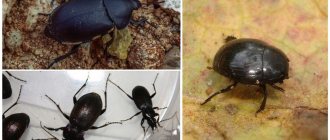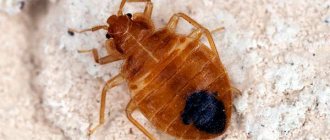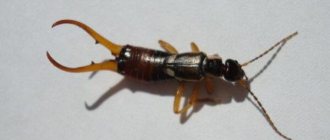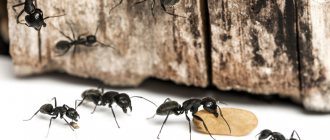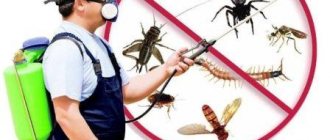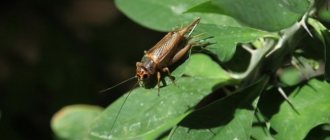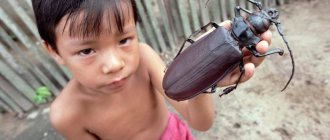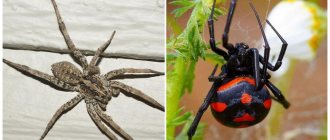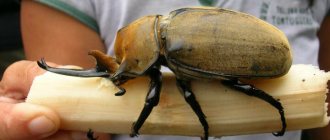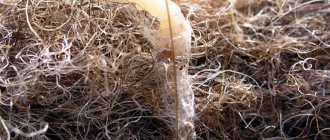For insects, a human home is a whole world. Here they hide, find food, reproduce and die. Some of them are harmless, others cause some discomfort, and others are harmful or even dangerous. And although, theoretically, any insect can get into an apartment, there are species that have firmly established themselves next to people. In most cases, the person himself creates suitable conditions for them:
- leftover food in sinks, dishes, trash cans;
- infrequent cleaning;
- presence of places with high humidity;
- gaps and cracks in baseboards, walls, wallpaper.
Cockroaches
This is a classic type of synanthropic insect. In your home you can find two main types
of cockroaches -
black and red
. The red one is more viable and actively displaces the black one. The Prussian came to Europe back in the 18th century from South Asia and is now found everywhere. Cockroaches contaminate and destroy food, can carry some diseases and have a repulsive appearance. The growth of their numbers can be very rapid and the fight against them turns into a real war. You can use dozens of folk methods or factory-made drugs. Among them:
- boric acid;
- various traps;
- ammonia;
- sprays, aerosols, gels and crayons.
To obtain the result, you need to follow the manufacturer's recommendations and carry out the treatment several times
.
Has proven itself well .
It is easy to apply, has a long-lasting effect, and the active substance is transferred between insects.
Ways to deal with house bugs
Although the exact method can only be determined by knowing the type of beetle, there are a number of principles for protecting your home.
- Find and destroy the nesting site.
- Carry out general cleaning of the premises.
- Check all things that are at risk.
- Carry out temperature effects, if possible.
- Use traditional methods of prevention that repel with smell.
- Sprinkle boric acid or chemicals that will help destroy animals that escaped during harvesting or hatched.
- Some can be caught in special traps, homemade or purchased.
Ants
The ants themselves do not pose a serious danger, but the huge number of small insects scurrying around causes discomfort. Moreover, they penetrate into the smallest crevices and get into almost all products. Some species inflict quite painful bites
.
Mostly black, red and red ants
.
The life of all ants is built around the “queen” - the main female who reproduces offspring. Therefore, if there are a lot of ants, by following their path, you can find the place where the main nest is located
. The destruction of the colony must begin from this place, since the fight against single ants is ineffective. To remove these insects, boric acid baits, traps and crayons are used. However, such methods do not give quick results. If you have been able to reliably establish the center of the colony, it is better to treat it with modern aerosols or sprays.
Medvedki
This insect, with its unusual appearance, makes one think of space aliens. If you want to have such an “alien” 6-7 cm long at home, you will need an insectarium with a base size of at least 50x50 cm. Since the mole cricket lives in the ground, the soil layer should be at least 10-15 cm. The soil must be sprayed once a day settled water.
You can feed the mole cricket with root vegetables, plant tubers, and white bread crumbs. Take care of the metal mesh lid. Air flow into the insectarium is necessary, but the insect will easily tear the fabric.
clothes moth
Clothes moths are widespread throughout the world. Spoiled clothing made of wool or silk is the calling card of the caterpillars of this inconspicuous moth. At dusk or when you turn on the lights at night, you can sometimes see a small butterfly fluttering around the apartment. These are, as a rule, males who do not pose any particular danger and do not have a gnawing mouthpart. Females lay eggs in the folds of clothing made from natural materials. This requires three conditions - absence of drafts, humidity and comfortable temperature. Therefore, closets with winter clothes that are rarely opened in the summer are an ideal place for moths to develop. As a preventive measure, we can recommend regular ventilation and drying of linen and wardrobes. Scent repellents work well:
- citrus peels;
- dry lavender.
In case of severe damage, it is already worth using strong insecticides. Some products, such as Dr.Klaus moth spray, have a combined effect. It can be used both for the destruction of moths and larvae, and for repelling with a long period of action.
Parasitic wasp (rider)
0
Source:
They are primarily parasitoids of other animals, mainly other arthropods. Many of them, such as the Braconidae family and Trichogramma, are beneficial to humans because they regulate the number of agricultural pests. Ichneumon wasps differ from ordinary wasps in the absence of a sting as such; it is replaced by an ovipositor. Nevertheless, in the English-language literature, parasitic wasps are usually called parasitic wasps. With the help of an ovipositor, parasites lay eggs in the body of larvae (caterpillars) or in the eggs of their victims. The prey consists mainly of larger insects, such as butterfly caterpillars, beetle larvae, and other arthropods, including some species of spiders. The rider typically positions himself over the victim (like a rider on a horse, hence the name) and inserts the ovipositor. The wasp larvae hatch inside the victim and feed on their organs, gradually destroying them. Species of the genus Megarhyssa of the superfamily Ichneumonidae have a thin ovipositor several centimeters long, used for penetration into tree trunks. Fortunately, people are not considered suitable incubators for wasp babies and it does not lay larvae in humans.
Food moth
The subject of food moth attacks are all kinds of cereals, dried fruits or nuts
.
It does not have a silvery tint on the wings, is smaller than the clothes one, and the overall color can vary depending on the species. The larva is a small, white worm. If flying small moths are found near food storage areas, it is necessary to immediately inspect the stored cereals, flour, pasta, nuts, etc., especially those that have not been used for a long time
. If larvae and cocoons are found, it is better to dispose of the products in which they are found. Storage areas should be thoroughly washed and treated with special products.
Flour beetle
The mealworm cannot be called a small insect; it reaches 1.5 centimeters in length. The Khrushchak is interested in flour, bran, and various cereals. As a rule, it ends up in the kitchen with purchased products.
It is advisable to throw away groceries that are infested with insect larvae and pupae; pest excrement and their skins are quite difficult to clean out of any cereal.
General cleaning will also help to destroy the beetleworm; pay special attention to baseboards and the inner surfaces of cabinets. To prevent the recurrence of pests, store bulk products in hermetically sealed containers.
Ground beetle
Ground beetles belong to one of the largest families and live in all climatic zones
.
These are, as a rule, quite large beetles (as can be seen in the photo), running and flying well. During the year in our climate they manage to give birth only once. For the most part, ground beetles are harmless to both humans and cultivated plants, although there are species that cause some damage to young plantings
.
The most dangerous of them is the bread ground beetle
, which eats cereal grains. It is combated with the help of pesticides. Predatory ground beetles, on the contrary, bring benefits by eating small pests. If a beetle gets into a house, you can simply catch it and release it, since their numbers are rarely high.
Fruit midges
Drosophila (fruit flies, fruit flies) are very small flying insects. They appear especially often in the summer and autumn, when berries and fruits ripen. Midges are attracted to rot that forms on products of plant origin.
In order not to breed hordes of midges in the kitchen, you need to inspect vegetables and fruits, even if they are slightly spoiled, feel free to throw them away, but it is best to eat them on time.
If you didn’t keep track and the midges have already appeared, eliminate them using a homemade trap. Take a few pieces of slightly rotten fruit and place them in the bottle. A sheet of paper folded into a funnel shape will help make the passage narrower. The midges, attracted by the aroma of the fruit, will fly into the bottle and will no longer be able to get out of it; all you have to do is seal the neck and throw away the container.
Spider
People have a traditionally negative attitude towards spiders, due to multiple superstitions. In fact, we do not have dangerous species of these arthropods. Traces of their vital activity - cobwebs
, which do not characterize the owners of the house from the best side, great By destroying flying insects, spiders bring undoubted benefits, but their very presence in the apartment causes discomfort. The most effective way to combat spiders is to keep your home clean. By destroying the web, a person forces the spider to look for more comfortable conditions elsewhere.
Conclusion
Various parasitic insects can live in an apartment or house. They make a person's life unbearable. Discomfort, pain, lack of sleep and constant stress - these are the consequences of living with such insects under the same roof. In addition, do not forget that most of them are carriers of dangerous infectious diseases.
You can try to fight parasites yourself. Some of them can be quickly removed from their homes. And in the fight against some, you will have to use the services of SES specialists. They use high-quality, concentrated insecticides that are guaranteed to kill pests in your home.
Silverfish
This representative of the bristletail appeared in the tropics. And in apartments, the silverfish chooses places that remind it of its ancestral home - with high humidity and temperature
.
She is nocturnal and does not tolerate bright light
. The silverfish does not fly, but runs quite quickly. Its appearance resembles ancient crustaceans - a spindle-shaped, flattened body, divided into segments. Feeding on sugar, flour, wood glue, paper and leather, the insect causes harm, albeit minor. Silverfish damage only becomes greater when the insect population increases greatly. Moreover, it is difficult to track this, since they are extremely secretive animals. To eliminate insects, repellents, traps and some chemicals are used.
Mantis
As pets, praying mantises are fun to watch. There will be no difficulty in feeding, since they are aggressive and quickly snatch the offered food from the tweezers. It is well known that a female can eat a male during copulation. However, this does not always happen, especially if the female was well fed before mating.
Perhaps a more appropriate name for these insects would be “predatory mantis.” These guys are ruthless when it comes to food. The lifespan of a praying mantis is about 6 months, with many living much shorter. This is explained as a natural form of population control, as the female mantis lays between 100 and 400 eggs at a time.
Dust mites
Microscopic arachnids
,
the size of which does not exceed 0.3 mm
.
This is a person’s constant neighbor, whose existence many do not even know about. The basis of dust mite nutrition is dead human skin
. It does not directly harm people, but with a high population, allergic reactions to its secretions are possible. It is impossible to completely remove dust mites; you can only reduce their numbers. To do this, you need to frequently wet clean the places where dust accumulates, vacuum and wash the bed regularly, clean upholstered furniture and outerwear. You can also periodically treat surfaces with special products.
stick insect
The stick insect is an interesting insect that grows up to 10-15 cm in length, and with this size it is perfectly camouflaged among branches and leaves. The game “find the stick insect” will be a fun activity for your child.
Living conditions are quite easy to create. For one individual, you need to allocate a space of at least 15x15x30 cm. If there is not enough space, then insects can fight for territory. During the day, the temperature must be maintained at +25-27 °C, at night - not lower than +18 °C. Coconut fiber or shavings, peat, or special purified sand can be used as bedding in the insectarium. Of course, there must be branches and sticks among which insects can move and find shelter. You can put living plants in the container that are not poisonous to pets.
It is easy to provide food for stick insects. Green leaves of any fruit trees and shrubs are suitable for this: apple trees, rose hips, currants, plums, etc.
Bed bugs
When bedbugs appear in an apartment, the owners understand that there is a serious problem. The proximity of these insects means painful bites, allergies, and a repulsive odor
.
The size of the bug depends on its filling with blood; in its normal state its length does not exceed 3 mm, after saturation it can reach 8 mm. It appears to have originally lived in the Middle East, but over time it has spread throughout the world. The lifespan of a bug
is quite long for an insect -
about 1 year
.
This species is very resilient, adapts well to unfavorable conditions, can migrate, and uses a variety of shelters and donor hosts. You can remove bedbugs yourself using high-quality modern means. So, with Dr.Klaus flea and bedbug aerosol
you need to treat the seams and folds of furniture, baseboards, and other secluded places. The procedure must be carried out repeatedly, since the drugs do not affect dormant eggs, and about 2 weeks pass from laying to hatching.
House beetles
Even in a clean apartment there are uninvited six- and eight-legged guests, and what can we say about microscopic neighbors that can be on the skin of people and animals. They usually enter the house through windows, window sills, any cracks, drainpipes, and ventilation holes. No human habitation could do without their presence.
In the kitchen you can most often find:
- Cockroaches;
- Weevils;
- Muravyov;
- Senoyedov;
- Fruit flies;
- Flour beetles.
Cockroaches are the fastest and hardiest creatures that have lived on earth for 4 million years and number 4,000 species. They move at a speed of about 400 km/h, can not breathe for about an hour and can go without food for 1 month.
Weevils. They pierce any packaging with their proboscis. These insects breathe using microscopic holes in the skin. Hiding from direct sunlight in boxes with cereals, they lay up to 400-500 eggs.
Ants often enter apartments along with fruits and vegetables from the home garden. They feed on leftover human food. The bites of some ant species are very painful to humans. Therefore, it is better to get rid of them quickly. This is fairly easy to do by spraying the area with insect repellent spray.
Hay eaters appear in any room with constantly high humidity. These are small, fragile white insects with transparent wings. They feed on organic food, but can go without food for a long time. Mold is a favorite delicacy that attracts hay eaters to the apartment. You can get rid of their presence by eliminating pockets of constant dampness.
Fruit flies. Their larvae develop in plant debris: fruits, vegetables, etc. They are also called fruit flies. Like flies, they are carriers of infection. Whole swarms of flies may appear over rotten fruit. You should get rid of them by throwing out garbage on time and following the rules for storing and processing fruits and vegetables.
Flour beetles. An adult beetle reaches 12−19 mm in length. Its body is flat, light brown, and reddish below. Their larvae are 2 mm in size, yellow in color and have no eyes. They eat cereals and flour. In addition to grain and flour, the beetle can be found in starch, dried fruits, seeds, and also feed on fabric and wool.
The bedroom is most often inhabited by:
- Dust mites;
- lice;
- Bedbugs;
- Carpet beetles.
Ticks are creatures that feed on dead skin particles. Therefore, bed linen, mattresses, sofas and pillows are like a 24-hour dining room for them. On average, there can be about 10 billion individuals in each person's bed. Dust mites cause allergic reactions in people with asthma. The dust that forms from the remains of their vital activity irritates the respiratory tract and lungs. In 1 sq. m of carpet, there are about 100,000 of them. Ticks do not survive at temperatures below zero.
Kozheed. His body contains enzymes that can process keratin. The larvae of the leather beetle eat wool, thereby spoiling woolen items. But at the same time, they can be useful because they eat dead insects and fallen hair.
Blood-sucking parasites
Lice . Contrary to popular belief, lice grow in clean hair. Clean hair is easier to move through, as it slips less due to the lack of oil on it. Long hair is more likely to harbor lice than short hair, because it is easier to attach to it. They cling to hairs using six legs with claws. On average, no more than 5-10 individuals live on an infected head.
There are still cocoons of lice in the hair. The louse, being on the head for about a month, lays many eggs. If you do not remove lice in time, everyone around you can become infected. Insects drink blood at least once a day. Lice saliva prevents blood clotting. Initially, the body of a young individual is colorless, but its color changes after the first meal.
Body lice hide in the folds of dirty clothes. Their lifespan is twice that of a head louse. They are more fertile. Dangerous diseases can be transmitted through their dried excrement. For example, a body louse can become a carrier of typhus and other diseases.
Fleas .
Thanks to its flat, armored body, the flea easily penetrates animal fur. With its large jaws it pierces the skin and blood vessels. Two pumps in her head help her suck out blood. Fleas move with the help of several pairs of legs and can jump up to 20 cm. These parasites are carriers of many diseases, the most dangerous of which is the plague. Bedbugs are parasites of warm-blooded animals and people; they feed on their blood. It is believed that they originally existed in caves. Bedbugs feed on blood at all stages of development. Most people do not notice bedbug bites. You can detect bedbugs in bed only by numerous brown spots. If a room is heavily infested with bedbugs, a specific smell may appear.
Mosquitoes are blood-sucking insects. Moreover, only females feed on blood. Their upper and lower lips are elongated and form a kind of pencil case, which contains sharp and thin needles. Unlike females, males have poorly developed these organs and they do not bite, but feed only on plant sap. Mosquito larvae and pupae live in stagnant bodies of water. In cities, they fill warm and humid rooms, such as the basements of residential buildings.
They are parasites and can carry infection. As a result of the bite, a person experiences severe itching and may develop eczema and hives. You won't be able to get rid of them completely, you can only control their number.
Harmless bugs
The following insects can be found in the bathroom at home:
- Silverfish;
- Woodlice;
- Pintails;
- Flycatchers;
- Spiders;
- Centipedes.
The woodlouse is a garbage-collecting insect. Its body, covered with “armor,” reaches a length of no more than 20 mm. They eat rot, mold, excrement and members of their own species. Six times a year they shed their shell, becoming completely defenseless. To absorb oxygen, their gills, which are located on the abdomen, must remain moist.
These insects are able to absorb water from both ends : the mouth and tubes near the rectum. Due to the high calcium content in their shells, there was a time when these insects were sold in pharmacies as a cure for indigestion. This is how they got the name “pill bugs.”
Silverfish. Little bugs that eat literally everything thanks to their body’s ability to produce cellulase, a breaking down enzyme. These microscopic black bugs can be seen on book spreads. They are also called bookworms.
Pintails. Another name for this insect is earwig or mite. Also the most common name is pincher. This is an omnivorous insect. In apartment buildings, they are most likely attracted by the presence of a variety of food and other insects, which they also feed on (or rather, their remains). Pintails reach 12-17 mm in length. Long antennae extend from the head. They can fly, but are reluctant to use their wings.
They deserve special dislike because they bite painfully or pinch with their tongs, biting through the skin until it bleeds. But they do this solely for the purpose of self-defense. In addition, they are very useful because they eat aphids.
Flycatchers. They start in different rooms and look like furry caterpillars. They move quickly and feed on other insects: flies, mosquitoes, midges, and silverfish. They may bite in self-defense.
Spiders weave their silk webs using special glands. The thread they throw out hardens when exposed to air. They calmly move along their web, waiting for their prey. If the victim is caught, then she will never get out. The web in the corners looks unaesthetic, but still the benefits of the spiders themselves are undeniable. They kill harmful insects. Many spiders catch and eat insects twice their own weight in a day.
Centipedes. The length of centipedes ranges from 2 mm to 30 mm. Millipedes belong to the superclass of invertebrates, although some people mistakenly consider them insects. Kivsyaki is one of the types of centipedes common in Russia. They look very impressive because they look like a long black smooth caterpillar with many legs.
Flea
There are now more than 2,000 species of fleas. This insect is well known to those who have pets, since most often cats and dogs are its owner
.
Fleas feed exclusively on the blood of warm-blooded animals.
Possessing high fertility, they multiply very quickly and cause great inconvenience to both animals and humans. Found on all continents. Various drops, sprays and aerosol insecticides are more often used to treat premises.
Silkworm
The silkworm has long been known to the peoples of Asia as a source of valuable fiber, from which they make an expensive and beautiful material - silk. However, the life cycle of the silkworm is very interesting to observe, which is why butterflies are increasingly kept as pets. Children especially love them. After all, something changes in the insectarium every day.
The hairy, almost white butterflies do not live long, about 10 days, and do not feed during their life. But tiny larvae emerge from the laid eggs, and they grow literally before our eyes. The main thing is to provide them with enough food. The larvae eat mulberry (mulberry) leaves and do not refuse to gnaw on anchar, figs, and ficus. Given suitable conditions and good nutrition, you can observe the life of insects and their magical transformations for a long time.
Cricket
In appearance, the cricket resembles a hybrid of a cockroach and a grasshopper
. The insect's homeland is considered to be the Far East and North Africa, and is now widespread everywhere except Antarctica. The length of an adult reaches 25 mm. Everyone has heard the “singing” of a cricket live or in movies. This property can cause inconvenience at night. Crickets usually enter residential areas closer to autumn, remaining in fields and gardens in the summer. Although they feed on organic food, due to their small numbers, they do not cause much damage. Therefore, they are not engaged in a targeted fight against them.
Giant leaf beetle
Size – up to 12.5 cm.
For beginner insect lovers, the easy-to-keep leaf beetle is suitable. It looks like a tree leaf, which is an excellent camouflage for it. It is better to keep such creatures in pairs or groups, like any social animals. But it is unlikely that you will be able to observe them during the daytime: they are nocturnal. They feed on blackberry, rose and oak leaves. When maintaining it, it is important to adhere to temperature conditions and humidity, which can be ensured by spraying the substrate and leaves.
Louse
A small parasite, up to 5 mm long, has been a human companion since ancient times
.
It causes a lot of discomfort with itchy bites and is a carrier of many dangerous diseases
. The short lifespan of the louse is compensated by its incredible fecundity and short development cycle for such a small insect. The mouthparts are piercing-sucking type. Pediculosis, although it develops more often in unsanitary conditions, can be “found” anywhere - from the swimming pool to shops. On humans, lice are destroyed with special ointments, gels and shampoos. Things that a person with lice has come into contact with can be washed in hot water or put in plastic bags and left for a week. During this time, adults and nits die from starvation.
Domestic blood-sucking insects. Parasites
As you can easily guess from the name of the group, these insects parasitize humans, that is, they bite and feed on our blood. Such insects, of course, include bed bugs , mosquitoes, fleas , and lice. Getting along with such insects at home is extremely difficult and unnecessary, because in addition to the discomfort from bites, there is a possibility of blood poisoning with pathogens carried by parasites.
Domestic bed bugs
Inconspicuous small brown insects with a flattened body, leading a hidden lifestyle during the day. At night, when people sleep, bed bugs emerge from their shelters to quench their thirst for blood.
In the morning after a bedbug attack, itchy bite marks are found on the human body. At the same time, it is difficult to detect the insects themselves, while there are few of them in the apartment, but traces of their excrement and blood stains on the bed linen are clear signs of a home being infected with bedbugs, but in order to avoid getting an infection from the parasite, a person should take up the destruction of bedbugs without delay. . Bedbugs are potential carriers of smallpox, hepatitis B, tularemia, tuberculosis, typhoid fever, anthrax and others.
House fleas
When fleas get into people's homes, they do not get lost, but almost immediately begin to bite a person. Typical indications of the presence of fleas in an apartment are multiple bites on the legs in the lower part.
Fleas are even smaller in size than bed bugs and are dark brown or black in color. Fleas do not hide in shelters, but bite a person or pet at any time. These small insects move around the apartment by jumping over impressive distances.
Despite their insignificant size, fleas, like bedbugs, pose a serious threat to human peace and health. Flea bites are much more painful than bed bug bites, and they are also potential carriers of dangerous infections: bubonic plague, typhus, hepatitis and encephalitis, pulicosis and others. The destruction of fleas in an apartment is achieved by one treatment with special preparations, since insects are very sensitive to poisons, and due to the fact that they actively move along the floor surface, they necessarily end up on a surface treated with poison.
House lice in the apartment
Formally, the home for head lice is not our home, but the person himself, or rather his hairline, where the lice live and reproduce safely, while feeding on blood. Body lice prefer to live on the fibers of clothing and in folds. From clothing, body lice easily enter the human body and begin to bite.
Although lice themselves cannot be found in an apartment, they themselves and their nits (eggs) can easily be found on a person’s personal items, for example, on combs or dressing gowns, which is how lice spread among the inhabitants of an apartment or house.
Lice bites are also quite painful; they provoke constant scratching on the head. Infection of a person with lice is called pediculosis. Removing lice is quite difficult; treatment is often accompanied by complete cutting of the hair on the head.
Lice are also potential carriers of typhus.
Fly
The most common housefly found in homes is a medium-sized dipteran. This insect is annoying with its intrusiveness, is a carrier of diseases, spoils food and contaminates any surfaces
.
High fecundity and omnivorousness make its proximity extremely unpleasant. The most effective means are the treatment of premises with sprayed preparations and the installation of stationary traps - tapes. , effective tapes contain attractants that attract flies
. It has such qualities.
Woodlice - how do they appear and how are they different?
Unpleasant woodlice, which make themselves felt in a house or apartment from time to time, are difficult to classify as permanent household insects. This is an example of an arthropod from the class of higher crayfish. However, woodlice can be found at home quite often.
Remembering what types of domestic insects pose a danger to humans, it is worth noting that woodlice are almost completely harmless. These arthropods are not capable of causing damage to human health and all they can do is spoil young plants in the house or stocks of vegetables.
Insects appear in rooms with high humidity levels. Most often this is the kitchen, bathroom, toilet. Here they hide from bright light, just like most domestic insects. Woodlice choose food scraps as a source of food.
Fighting woodlice is very simple - just work to create conditions that are unacceptable for them with low humidity levels and a lack of food sources. Insecticides Delta-Zone, FOS, Tsifoks and others are suitable as auxiliary preparations.
Centipede
In damp and warm basements, in sewer niches, and attics, you can find these relatives of insects, quickly rearranging several pairs of legs. Centipedes, or more precisely centipedes
, include hundreds of species, many of which can be found at home.
They pose no danger to humans , although they can bite sensitively if disturbed
.
Their main food is rotting vegetation or other invertebrates
. If you don’t like such tenants, you should clean and ventilate technical rooms more often.
How dangerous are parasitic insects?
Having found out what insects can live in the apartment, let’s make a small digression. Not all “human neighbors in the home” belong to the class of insects. Animals, centipedes, and other types of pests live nearby. Many insect pests - the list includes cockroaches, Orthoptera, termites, Coleoptera and others - are very dangerous to humans.
They are carriers of serious diseases - typhoid, dysentery, Chagas disease, malaria, encephalitis and many others. Therefore, to the question of what insects can be kept at home, the answer will be one - none.
Carpet beetle
The size of these beetles varies from 1 to 10 mm, depending on the species. One of the most dangerous pests in the home
. Since the family has about 600 species, it has “specialists” in eating everything that a person has:
- powdered milk and cheese;
- cereals and pasta;
- fur and wool;
- leather and dried fish;
- any biological collections and other dehydrated organic food.
The fight lies in the constant inspection of any natural products and the protective treatment of stored products.
Giant Weta
Size – up to 10 cm.
“God of Bad Appearances” or “God of Terrible Things” is what this giant grasshopper is called. And no wonder: he really looks creepy. And the huge size and weight of up to 35 grams only complete the frightening image. However, for those who do not care about appearance, Weta can become a good pet. Because of its weight, it is considered the heaviest insect in the world, and therefore Ueta is unable to fly or jump. But representatives of the species love carrots very much, as evidenced by many pictures and videos from the Internet.
Mosquitoes
In the warm season, the mosquito is perhaps the most important enemy in apartments and, especially, country houses. A small insect, due to its high numbers, can make any vacation unbearable
. A flying mosquito creates a thin squeak due to the high speed of flapping its wings. Mosquitoes develop very quickly; depending on the water temperature, it takes from two to eight days for an adult insect to emerge from the egg. There are many methods for controlling mosquitoes, ranging from repellents applied to skin and clothing to fumigators and smoldering coils. The number of mosquitoes in a country house is influenced by the presence of nearby small, well-heated bodies of water.
Exotic fashion in modern families
In the modern world there is a real hype for owning exotic animals. Some explain this by profit - breeding such animals is quite profitable, others like the understanding that no one they know has such an animal. Simply put, people indulge their pride, or follow the lead of children asking for “not a mouse, not a frog, but an unknown little animal.”
First of all, the adoption of exotic pets was influenced by the fashion trend of Russian and foreign stars, who post photographs and videos with exotic pets on their social pages.
For example, the famous boxer Mike Tyson at one time kept two Bengal tigers. Of course, this cost him quite a large sum, and besides, the animals required constant training and attention. After some time, the boxer sold his predatory pets due to financial difficulties. He also bred pigeons and organized races with their participation.
The next example is the famous American actor George Clooney, actress, singer and songwriter Miley Cyrus and English football player David Beckham, who are very fond of their pets - little pigs (mini-pig). Unfortunately, George Clooney's mini-pig named Max died in 2006, and after that the actor did not have pets, believing that no one would replace his deceased friend.
Leonardo DiCaprio got himself a giant African tortoise back in 2010, Michael Jackson got a chimpanzee, Elvis Presley took care of a kangaroo given to him by his friends as a joke, Nicolas Cage placed an octopus in a huge aquarium and keeps two king cobras, and Justin Bieber often appeared in photographs with small boa constrictor.
Looking at their idols, many people are inspired to purchase them, and get exotic pets for their own reasons. What types of exotic pets are the most popular to keep, and what precautions must be taken, read below.
springtail
Small arthropods are most often found in the soil of indoor plants
.
Their main food consists of decaying plant debris, mosses and lichens
.
Sometimes tender shoots of living plants are damaged. They are very widespread and are one of the most ancient animals. Springtails are one of the humus-forming plants, so they are even beneficial in open ground.
. They are not dangerous for an adult plant, and when growing seedlings, you need to use proven soil without rotted organic matter.
Insects, as very plastic and flexible creatures, will always be close to humans. They live not only in a village house, but also in new city high-rises. However, it is possible and necessary to control their numbers and fight them, if necessary.
Woodlice
0
Source:
Generally speaking, woodlice are not insects (they are crustaceans), but they lead approximately the same lifestyle as cockroaches. When threatened, they curl up, simulating death. In most cases, wood lice appear only in those apartments where it is constantly damp, for example, water leaks from pipes. These insects are excellent indicators of various plumbing breakdowns and depressurization of flanges. The appearance of woodlice in an apartment, first of all, should worry lovers of indoor flowers, because if measures are not taken in time and they are not removed, the plants will soon die. First of all, these insects harm moisture-loving tropical plants that have a thin and delicate root system (orchid, fern, cactus), affecting it specifically, so if you have just such plants, then you should fight more actively.
Carpet beetles: what harm do they cause?
In houses and apartments, not only mosquitoes, bedbugs and cockroaches, but also some types of beetles can be annoying. So, for example, bugs in an apartment (photos and names will help you better navigate among the variety presented) called skin beetles live in close proximity to a person so that the latter most often does not suspect about him.
The reason is simple - adult individuals are so small that they are almost impossible to notice. The easiest way to find insects is in places where paper, clothing or skin accumulate, which are a source of food for them.
Fighting beetles is not difficult. Aerosol insecticidal preparations, as well as some types of folk remedies - lavender and wormwood, for example, the smell of which is intolerable to insects, both adults and larvae, have an excellent effect.
